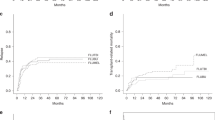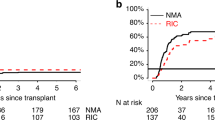Abstract
Transplant-related mortality and morbidity (both short and long term) have limited the effectiveness of SCT in children with both malignant and nonmalignant diseases. Reduced-intensity preparative regimens permit engraftment of allogeneic cells without many of the toxicities associated with standard TBI- and non-TBI-based conditioning. We review the concepts that underlie reduced-intensity transplantation (RIT) and highlight the experience of the technique in children. Although acute organ damage may be reduced after these transplants, the overall incidence of severe infections and of GvHD may be similar to that seen after standard-intensity transplantation. The relatively small numbers of children who have received RIT and the newness of the technique preclude long-term follow-up with which to monitor the incidence of associated long-term side effects and disease-free survival. Future refinements in RIT and appropriate patient selection for these procedures will hopefully extend its utility in the future.
This is a preview of subscription content, access via your institution
Access options
Subscribe to this journal
Receive 12 print issues and online access
$259.00 per year
only $21.58 per issue
Buy this article
- Purchase on Springer Link
- Instant access to full article PDF
Prices may be subject to local taxes which are calculated during checkout
Similar content being viewed by others
References
Huss R, Deeg HJ, Gooley T, Bryant E, Leisenring W, Clift R et al. Effect of mixed chimerism of graft-versus-host disease, disease recurrence and survival after HLA-identical marrow transplantation for aplastic anemia or chronic myelogenous leukemia. Bone Marrow Transplant 1996; 18: 767–776.
Andreani M, Nesci S, Lucarelli G, Tonucci P, Rapa S, Angelucci E et al. Long-term survival of ex-thalassemic patients with persistent mixed chimerism after bone marrow transplantation. Bone Marrow Transplant 2000; 25: 401–404.
Fink PJ, Shimenkevits RP, Bevan MJ . Veto cells. Annu Rev Immunol 1988; 6: 115–137.
Bachar-Lustig E, Reich-Zeliger S, Gur H, Zhao Y, Krauthgamer R, Reisner Y . Bone marrow transplantation across major genetic barriers: the role of megadose stem cells and nonalloreactive donor anti-third party CTLS. Transplant Proc 2001; 33: 2099–2100.
Reisner Y, Gur H, Reich-Zeliger S, Martelli MF, Bachar-Lustig E . Hematopoietic stem cell transplantation across major genetic barriers: tolerance induction by megadose CD34 cells and other veto cells. Ann NY Acad Sci 2003; 996: 72–79.
Das M, Saikia TK, Advani SH, Parikh PM, Tawde S . Use of reduced intensity conditioning regimen for allogeneic transplantation in patients with chronic myeloid leukemia. Bone Marrow Transplant 2003; 32: 125–129.
Cohen J, Gandhi M, Naik P, Cubitt D, Rao K, Thaker U et al. Increased incidence of EBV-related disease following paediatric stem cell transplantation with reduced-intensity conditioning. Br J Haematol 2005; 129: 229–239.
Mielcarek M, Martin PJ, Leisenring W, Flowers ME, Maloney DG, Sandmaier BM et al. Graft-versus-host disease after nonmyeloablative versus conventional hematopoietic stem cell transplantation. Blood 2003; 102: 756–762.
Carvallo C, Geller N, Kurlander R, Srinivasan R, Mena O, Igarashi T et al. Prior chemotherapy and allograft CD34+ dose impact donor engraftment following nonmyeloablative allogeneic stem cell transplantation in patients with solid tumors. Blood 2004; 103: 1560–1563.
Dror Y, Freedman MH, Leaker M, Verbeek J, Armstrong CA, Saunders FE et al. Low-intensity hematopoietic stem-cell transplantation across human leukocyte antigen barriers in dyskeratosis congenita. Bone Marrow Transplant 2003; 31: 847–850.
Pavletic SZ, Bociek RG, Foran JM, Rubocki RJ, Kuszynski CA, Wisecarver JL et al. Lymphodepleting effects and safety of pentostatin for nonmyeloablative allogeneic stem-cell transplantation. Transplantation 2003; 76: 877–881.
Maris M, Storb R . The transplantation of hematopoietic stem cells after non-myeloablative conditioning: a cellular therapeutic approach to hematologic and genetic diseases. Immunol Res 2003; 28: 13–24.
Niederwieser D, Maris M, Shizuru JA, Petersdorf E, Hegenbart U, Sandmaier BM et al. Low-dose total body irradiation (TBI) and fludarabine followed by hematopoietic cell transplantation (HCT) from HLA-matched or mismatched unrelated donors and postgrafting immunosuppression with cyclosporin and mycophenolate mofetil (MMF) can induce durable complete chimerism and sustained remissions in patients with hematological disease. Blood 2003; 101: 1620–1629.
Slavin S, Nagler A, Naparstek E, Kapelushnik Y, Aker M, Cividalli G et al. Nonmyeloablative stem cell transplantation and cell therapy as an alternative to conventional bone marrow transplantation with lethal cytoreduction for the treatment of malignant and nonmalignant hematological diseases. Blood 1998; 91: 756–763.
Giralt S, Estey E, Albitar M, van Besien K, Rondón G, Anderlini P et al. Engraftment of allogeneic hematopoietic progenitor cells with purine analog-containing chemotherapy: harnessing graft-versus-leukemia without myeloablative therapy. Blood 1997; 89: 4531–4536.
Langer T, Beck JD, Gravou-Apostulatou C, Lang P, Handgretinger R, Greil J . Successful treatment of primary refractory acute myeloid leukemia with megadose stem cell transplantation, bone marrow boost and reduced intensity conditioining avoiding chronic graft vs host disease and severe late toxicity. Pediatr Transplant 2003; 7: 494–496.
Berger M, Vassallo E, Nesi F, Venturi C, Madon E, Fagioli F . Successful unrelated cord blood transplantation following reduced intensity conditioning for refractory acute myeloid leukemia. J Pediatr Hematol Oncol 2004; 26: 98–100.
Nobili B, Rossi G, De Stefano P, Zecca M, Giorgiani G, Perrotta S et al. Successful umbilical cord blood transplantation in a child with dyskeratosis congenita after a fludarabine-based reduced-intensity conditioning regimen. Br J Haematol 2002; 119: 573–574.
Del Toro G, Satwani P, Harrison L, Cheung YK, Brigid Bradley M, George D et al. A pilot study of reduced intensity conditioning and allogeneic stem cell transplantation from unrelated cord blood and matched family donors in children and adolescent recipients. Bone Marrow Transplant 2004; 33: 613–622.
Gómez-Almaguer D, Ruiz-Argüelles GJ, Tarín-Arzaga Ldel C, González-Llano O, Jaime-Pérez JC, López-Martínez B et al. Reduced-intensity stem cell transplantation in children and adolescents: the Mexican experience. Biol Blood Marrow Transplant 2003; 9: 157–161.
Jacobsohn DA, Duerst R, Tse W, Kletzel M . Reduced intensity haemopoietic stem-cell transplantation for treatment of non-malignant diseases in children. Lancet 2004; 364: 156–162.
Duerst RE, Haut PR, Venkaterwaran L, Kletzel M . Hematopoietic chimerism following immunoablative therapy for non-malignant disorders. Outpatient stem cell transplantation (SCT). Blood 2000; 96: 480.
Duerst RE, Jaconsohn D, Tse W, Kletzel M . Efficacy of reduced intensity conditioning with Flu–BU–ATG and allogeneic hematopoietic stem cell transplantation for pediatric ALL. Blood 2004; 104: 2314.
Iannone R, Casella JF, Fuchs EJ, Chen AR, Jones RJ, Woolfrey A et al. Results of minimally toxic nonmyeloablative transplantation in patients with sickle cell anemia and beta-thalassemia. Biol Blood Marrow Transplant 2003; 9: 519–528.
Shenoy S, Grossman WJ, DiPersio J, Yu LC, Wilson D, Barnes YJ et al. Reduced intensity conditioning therapy using campath -1H is successful for stem cell transplantation in non-malignant disorders. Blood 2004; 104: 1823.
Rao K, Amrolia PJ, Jones A, Cale CM, Naik P, King D et al. Improved survival after unrelated donor bone marrow transplantation in children with primary immunodeficiency using a reduced-intensity conditioning regimen. Blood 2005; 105: 879–885.
Veys P, Rao K, Amrolia P . Stem cell transplantation for congenital immunodeficiencies using reduced-intensity conditioning. Bone Marrow Transplant 2005; 35: S45–S47.
Horn B, Baxter-Lowe LA, Englert L, McMillan A, Quinn M, Desantes K et al. Reduced intensity conditioning using intravenous busulfan, fludarabine and rabbit ATG for children with nonmalignant disorders and CML. Bone Marrow Transplant 2006; 37: 263–269.
Horwitz ME, Barrett AJ, Brown MR, Carter CS, Childs R, Gallin JI et al. Treatment of chronic granulomatous disease with nonmyeloablative conditioning and a T-cell-depleted hematopoietic allograft. N Engl J Med 2001; 344: 881–888.
Kletzel M, Jacobsohn D, Tse W, Duerst R . Reduced intensity transplants (RIT) in pediatrics: a review. Pediatr Transplant 2005; 9: 63–70.
Ueno NT, Cheng YC, Rondón G, Tannir NM, Gajewski JL, Couriel DR et al. Rapid induction of complete donor chimerism by the use of a reduced intensity conditioning regimen composed of fludarabine and melphalan in allogeneic stem cell transplantation for metastatic solid tumors. Blood 2003; 102: 3829–3836.
Cooper N, Rao K, Gilmour K, Hadad L, Adams S, Cale C et al. Stem cell transplantation with reduced-intensity conditioning for hemophagocytic lymphohistiocytosis. Transplantation 2006; 107: 1233–1236.
Tolar J, Bonfim C, Grewal S, Orchard P . Engraftment and survival following hematopoietic stem cell transplantation for osteopetrosis using a reduced intensity conditioning regimen. Bone Marrow Transplant 2006; 38: 783–787.
Resnick IB, Aker M, Tsirigotis P, Shapira MY, Abdul-Hai A, Bitan M et al. Allogeneic stem cell transplantation from matched related and unrelated donors in thalassemia major patients using a reduced toxicity fludarabine-based regimen. Bone Marrow Transplant 2007; 40: 957–964.
Matthes-Martin S, Lion T, Haas OA, Frommlet F, Daxberger H, König M et al. Lineage-specific chimaerism after stem cell transplantation in children following reduced intensity conditioning: potential predictive value of NK cell chimaerism for late graft rejection. Leukemia 2003; 17: 1934–1942.
Author information
Authors and Affiliations
Consortia
Corresponding author
Rights and permissions
About this article
Cite this article
Yaniv, I., Stein, J. & on behalf of the EBMT Paediatric Working Party. Reduced-intensity conditioning in children: a reappraisal in 2008. Bone Marrow Transplant 41 (Suppl 2), S18–S22 (2008). https://doi.org/10.1038/bmt.2008.48
Published:
Issue Date:
DOI: https://doi.org/10.1038/bmt.2008.48
Keywords
This article is cited by
-
Successful outcome with reduced-intensity condition regimen followed by allogeneic hematopoietic stem cell transplantation for relapsed or refractory anaplastic large-cell lymphoma
International Journal of Hematology (2019)
-
Paediatric reduced intensity conditioning: analysis of centre strategies on regimens and definitions by the EBMT Paediatric Diseases and Complications and Quality of Life WP
Bone Marrow Transplantation (2015)
-
Reduced-intensity conditioning followed by allogeneic transplantation in pediatric malignancies: a report from the Société Française des Cancers de l’Enfant and the Société Française de Greffe de Moelle et de Thérapie Cellulaire
Bone Marrow Transplantation (2013)
-
Long-term remission in pediatric Wegener granulomatosis following allo-SCT after reduced-intensity conditioning
Bone Marrow Transplantation (2011)
-
Hematopoietic stem cell transplantation with reduced intensity conditioning from a family haploidentical donor in an infant with familial hemophagocytic lymphohistocytosis
International Journal of Hematology (2011)



